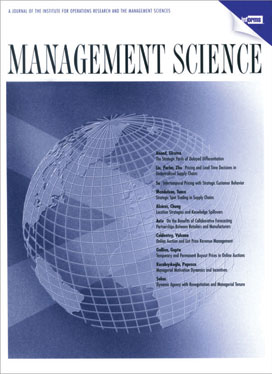Academic articles
Practitioner articles
Working papers
Books
Book chapters
Case studies
Other publications
Subject(s)
Human resources management/organizational behavior
Keyword(s)
Biography, psychodynamic approach, management science, clinical paradigm, universal motivational drivers, leadership development, group coaching, legacy
Secondary Title
The Palgrave handbook of organizational change thinkers
Pages
679–699
ISBN
978-3-319-49820-1
ISBN (Online)
978-3-319-49820-1
Subject(s)
Human resources management/organizational behavior
Keyword(s)
Collaboration, leadership development, networking, organizational culture, organizational structure, organizational change
James Reid, the newly appointed GM of Troubled Spain, has been given a mandate by the CEO of Troubled Inc. to turn the subsidiary around within six months. Troubled Spain has experienced several years of poor performance that cannot be explained by either sluggish demand or lagging technology. The case provides information about interviews that James had with several employees, describing the role of the employee and giving insights into the issues that they see the company facing. These interviews are complemented by three charts prepared by consultants that James hired to conduct an internal audit of collaboration, communication and informal leadership in the organization. James needs to transform the organization within six months; however, this implies changing relationships that have been developed over decades and clarifying roles and boundaries that have been blurred over many years. The case challenges students to take James' position and identify the issues of Troubled Spain to develop an action plan in order to address the challenges facing the company. James needs to address: 1) issues concerning Troubled Spain's formal structure, 2) issues regarding its informal structure, including leadership issues, and 3) issues stemming from the combination of both formal and informal features. Case B provides information about what happened next and may be distributed at the end of the session.
Los Andes University Case Collection
Subject(s)
Human resources management/organizational behavior
Keyword(s)
Collaboration, leadership development, networking, organizational culture, organizational structure, organizational change
James Reid, the newly appointed GM of Troubled Spain, has been given a mandate by the CEO of Troubled Inc. to turn the subsidiary around within six months. Troubled Spain has experienced several years of poor performance that cannot be explained by either sluggish demand or lagging technology. The case provides information about interviews that James had with several employees, describing the role of the employee and giving insights into the issues that they see the company facing. These interviews are complemented by three charts prepared by consultants that James hired to conduct an internal audit of collaboration, communication and informal leadership in the organization. James needs to transform the organization within six months; however, this implies changing relationships that have been developed over decades and clarifying roles and boundaries that have been blurred over many years. The case challenges students to take James' position and identify the issues of Troubled Spain to develop an action plan in order to address the challenges facing the company. James needs to address: 1) issues concerning Troubled Spain's formal structure, 2) issues regarding its informal structure, including leadership issues, and 3) issues stemming from the combination of both formal and informal features.
Los Andes University Case Collection
Subject(s)
Technology, R&D management
Keyword(s)
innovation search, novelty, professional services firms, R&D project selection, selection panels
Building on a unique, multi-source, and multi-method study of R&D projects in a leading professional service firm, we develop the argument that organizations are more likely to fund projects with intermediate levels of novelty. That is, some project novelty increases the share of requested funds received, but too much novelty is difficult to appreciate and is selected against. While prior research has considered the characteristics of the individuals generating project ideas, we shift the focus to panel selectors and explore how they shape the evaluation of novelty. We theorize that a high panel workload reduces panel preference for novelty in selection, whereas a diversity of panel expertise and a shared location between panel and applicant increase preference for novelty. We explore the implications of these findings for theories of innovation search, organizational selection, and managerial practice.
With permission of the Academy of Management
Volume
60
Journal Pages
433–460
Subject(s)
Technology, R&D management
Keyword(s)
Cybersecurity, wireless networks, telecommunications, Zwave, ZigBee, WiFi, smart grid, electrical systems, high criticality wireless networks, information security, critical infrastructures, cyber norms, internet governance, cyber legislation, ICT risk management, cyber metrics, internet jurisdiction, information security threats
Volume
1st ed.,
ISBN
978-3-319-52904-2
ISBN (Online)
978-3-319-52905-9
Subject(s)
Technology, R&D management
The researchers explored how organizations decide to invest in different innovations by studying a large professional service firm with offices in 37 countries. They analyzed all of the R&D project proposals submitted by its staff, including information about which projects received funding, and found that managers don’t always carefully weigh the pros and cons of each project and that biases can creep into the decision-making process. They found that there is a sweet spot of novelty that makes R&D committees more likely to fund a project, and that certain characteristics of the R&D selection committee can also influence funding decisions.
ISSN (Print)
0017-8012
Subject(s)
Human resources management/organizational behavior
Keyword(s)
Crowdsourcing science, replication, reproducibility
Researchers agree that replicability and reproducibility are key aspects of science. A collection of Data Descriptors published in Scientific Data presents data obtained in the process of attempting to replicate previously published research. These new replication data describe published and unpublished projects. The different papers in this collection highlight the many ways that scientific replications can be conducted, and they reveal the benefits and challenges of crucial replication research. The organizers of this collection encourage scientists to reuse the data contained in the collection for their own work, and also believe that these replication examples can serve as educational resources for students, early-career researchers, and experienced scientists alike who are interested in learning more about the process of replication.
This work is licensed under a Creative Commons Attribution 4.0 International License CC-BY.
Volume
4
ISSN (Online)
2052-4463
Subject(s)
Technology, R&D management
Keyword(s)
Big data & analytics, business mobility, E-Commerce, Internet of Things
Subject(s)
Strategy and general management
Keyword(s)
Organizations, crisis, BASF, Volkswagen
Subject(s)
Finance, accounting and corporate governance
Keyword(s)
Financial disintermediation, crowdfunding, consumer lending
JEL Code(s)
G01, G20, G21, G23
This paper analyzes the substantially growing markets for crowdfunding, in which retail investors lend to borrowers without financial intermediaries. Critics suggest these markets allow sophisticated investors to take advantage of unsophisticated investors. The growth and viability of these markets critically depends on the underlying incentives. We provide evidence of perverse incentives in crowdfunding that are not fully recognized by the market. In particular we look at group leader bids in the presence of origination fees and find that these bids are (wrongly) perceived as a signal of good loan quality, resulting in lower interest rates. Yet these loans actually have higher default rates. These adverse incentives are overcome only with sufficient skin in the game and when there are no origination fees. The results from the analysis in this paper provide more general implications for crowdfunding, its structure and regulation.
© 2016 INFORMS
Volume
63
Journal Pages
587–608
ISSN (Online)
1526-5501
ISSN (Print)
0025–1909


